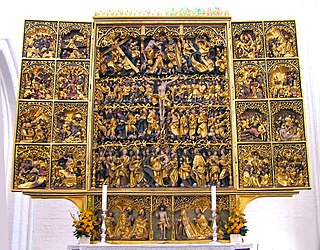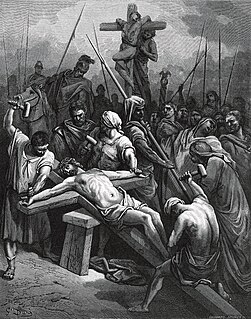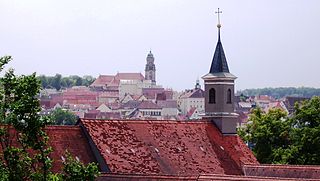An oratorio is a large musical composition for orchestra, choir, and soloists. Like most operas, an oratorio includes the use of a choir, soloists, an instrumental ensemble, various distinguishable characters, and arias. However, opera is musical theatre, while oratorio is strictly a concert piece – though oratorios are sometimes staged as operas, and operas are sometimes presented in concert form. In an oratorio the choir often plays a central role, and there is generally little or no interaction between the characters, and no props or elaborate costumes. A particularly important difference is in the typical subject matter of the text. Opera tends to deal with history and mythology, including age-old devices of romance, deception, and murder, whereas the plot of an oratorio often deals with sacred topics, making it appropriate for performance in the church. Protestant composers took their stories from the Bible, while Catholic composers looked to the lives of saints, as well as to Biblical topics. Oratorios became extremely popular in early 17th-century Italy partly because of the success of opera and the Catholic Church's prohibition of spectacles during Lent. Oratorios became the main choice of music during that period for opera audiences.
As Kapellmeister at Hamburg from 1768 to 1788, Carl Philipp Emanuel Bach composed 21 settings of the Passion narrative and 1 Passion oratorio.

The Brockes Passion, or Der für die Sünde der Welt gemarterte und sterbende Jesus, is a German oratorio libretto by Barthold Heinrich Brockes, first published in 1712 and going through 30 or so editions in the next 15 years.

The Easter Oratorio, BWV 249, is an oratorio by Johann Sebastian Bach, beginning with Kommt, eilet und laufet. Bach composed it in Leipzig and first performed it on 1 April 1725.

In Christian music, a Passion is a setting of the Passion of Christ. Liturgically, most Passions were intended to be performed as part of church services in the Holy Week.

The Princeton University Glee Club is the oldest and most prestigious choir at Princeton University, composed of approximately 90 mixed voices. They give multiple performances throughout the year featuring music from Baroque to Modern, and also tour internationally every other year. Every spring, they perform a major oratorio with professional soloists and orchestra, including most recently Mendelssohn's Elijah and Handel's Hercules. Currently the Glee Club is led by Gabriel Crouch.
Klaus Mertens is a German bass and bass-baritone singer who is known especially for his interpretation of the complete works of Johann Sebastian Bach for bass voice.

The Evangelist in the music of Johann Sebastian Bach is the tenor part in his oratorios and Passions who narrates the exact words of the Bible, translated by Martin Luther, in recitative secco. The part appears in the works St John Passion, St Matthew Passion, and the Christmas Oratorio, as well as the St Mark Passion and the Ascension Oratorio Lobet Gott in seinen Reichen, BWV 11. Some cantatas also contain recitatives of Bible quotations, assigned to the tenor voice.
Johann Sebastiani was a German baroque composer.
Jakob Stämpfli was a Swiss bass concert singer and an influential academic teacher and director of the conservatory in Bern, also a teacher in Saarbrücken.
Kurt Huber is a Swiss tenor for concert and Lieder.
Franz Kelch was a German bass-baritone lied and oratorio singer. His discography includes works of Johann Sebastian Bach, Dieterich Buxtehude, George Frideric Handel, and Claudio Monteverdi.
As Thomaskantor Johann Sebastian Bach provided Passion music for Good Friday services in Leipzig. The extant St Matthew Passion and St John Passion are Passion oratorios composed by Bach.

Sehet, wir gehn hinauf gen Jerusalem, BWV 159, is a church cantata by Johann Sebastian Bach. He composed it in Leipzig for the Sunday Estomihi, the last Sunday before Lent, and probably first performed it on 27 February 1729.
Samuel Besler was a German-Polish composer. He was cantor at St. Bernhardinus, Breslau, in 1602, then rector of the Gymnasium from 1605. As with Jakob Meiland in the generation before him, and Melchior Vulpius in his own generation, his St. Matthew Passion follows the model of Johann Walter's Lutheran historia, but with more elaborate choral numbers.
Michael Schopper is a German bass-baritone in opera and concert, and an academic teacher.

"All for Jesus, All for Jesus", also titled as "All for Jesus! All for Jesus!" and originally titled "For the Love of Jesus", is an English Christian hymn. It was written in 1887 by W J Sparrow Simpson intended as the closing chorus of John Stainer's "The Crucifixion" oratorio. It started to be published as a separate hymn later in 1901.

"Ein Lämmlein geht und trägt die Schuld" is a Lutheran hymn for Passiontide by Paul Gerhardt. The hymn text was first published in Johann Crüger's Praxis Pietatis Melica, starting from the lost 1647 edition. Wolfgang Dachstein's 16th-century "An Wasserflüssen Babylon" melody is commonly indicated as its hymn tune, although other settings exist.
Der Gemischte Chor Zürich is a mixed choir in Zurich, Switzerland, founded in 1863. One of the large oratorio choirs in the city, they perform regularly at the Tonhalle and internationally, often with the Tonhalle-Orchester Zürich, and traditionally with notable soloists such as Ilona Durigo, Karl Erb and Ernst Häfliger. Premieres have included works by Johannes Brahms and contemporary composers.










